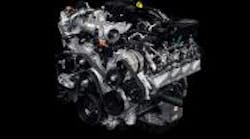“Developing the new 6.7-liter Power Stroke V-8 turbocharged diesel engine was an awesome endeavor.” –Adam Gryglak, lead diesel engine manager, Ford Motor Co.
Well, it might be an awesome endeavor, and from the looks of it, Ford Motor Co.’s new diesel engine may indeed make some waves in many segments of the light- and medium-duty truck market … but the company is sure being cagey about the big important details when it comes to this product; cagey to the point where a lot of key information won’t be released until the end of this year or maybe even early 2010. And such delay might at least in the short run generate more questions than answers about Ford’s new 6.7-liter Power Stroke V-8 diesel.
Now, don’t get me wrong here: I think this engine will only add gusto to Ford’s already popular F-Series Super Duty truck line. The information revealed in a conference call with the company’s lead engineers certainly shows they’ve done their homework, combining a new materials and technology to build an engine that will not only meet the tough 2010 emission regulations, but offer fuel economy, performance, and weight saving improvements as well.
As our lead story today notes, the new 6.7-liter Power Stroke V-8 diesel weighs in at 160 pounds lighter than product it replaces (product formerly built for Ford by Navistar) using a compacted graphite iron (CGI) engine block and aluminum cylinder heads. A unique “inboard” exhaust design means the exhaust manifolds reside in the “valley” of the engine instead of outboard, with the intake outboard of the engine – leading to essentially “flipped around” cylinder heads in comparison with previous V-8 engine architectures.
Adam Gryglak (below), Ford’s lead diesel engine manager, added that this exhaust design is an “automotive-industry first” for a modern production diesel engine in the conference call late yesterday and noted it offers several advantages.
First, the overall exhaust system volume is reduced, meaning air can be fed to the single turbocharger quicker for faster spool up and reduced lag, resulting in improved throttle response for the customer. Next, the improved packaging also places components that need to be in cooler air away from hot exhaust pipes, resulting in better thermal management and, by extension, better fuel economy.
“The physical size of the system is smaller, but more importantly, the air-handling part of the system is considerably smaller and that translates directly into the responsiveness of the engine,” said Gryglak, noting that the volume of the exhaust system feeding the turbocharger is smaller by about 50% because of the inboard exhaust system architecture.
All of this is being combined with a selective catalytic reduction (SCR) aftertreatment system, so the engine complies with the tough 2010 regulations.
OK, good stuff – so good that these features represent but a few of the 111 patents Ford filed in relation to this new diesel powertrain, Gryglak said; again, clear evidence that the OEM is wringing as much power, performance, and efficiency out of the diesel engine as possible while keeping it emission-compliant. Heck, this new engine is going to come to market B20 compatible as well, so it can operate on a maximum biodiesel blended fuel made up of 20% biodiesel and 80%regular petroleum diesel. That’s a big step, as some OEMs only certify B5 biodiesel blends for use in their diesels.
And yet … what are the horsepower and torque ratings for this new engine? We don’t know – for Ford is planning to stay mum on those numbers until the official launch date for the new product early next year. What will the surcharge be to cover the cost of all the emission-control technology required to comply with the 2010 rules? We don’t know that either – Ford doesn’t plan to reveal that until the end of this year. How about warranty coverage? Again, that’s unknown, until at least the beginning of 2010.
These are the big questions in the minds of many fleets – especially when it comes to the 2010 surcharges. A lot of OEMs have already released that information in the medium-duty segment, including Navistar, Daimler Trucks North America (owned by Germany’s Daimler AG), and Toyota’s Hino Trucks.
Will waiting until the end of the year to release this information boomerang on Ford? Or not? It’ll be interesting to see how that decision to withhold such details plays out in the truck market.






